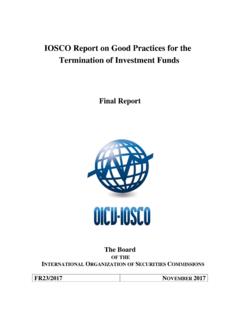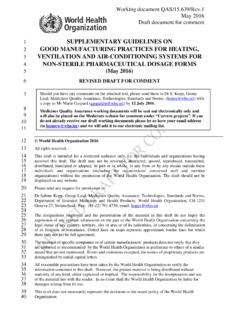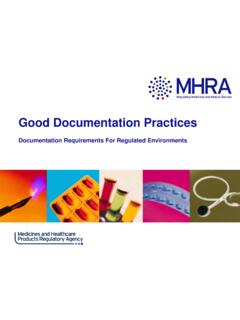Transcription of SECTION 3 Good production practices - fao.org
1 SECTION 3 - production , processing, storage, transport and distribution of feed and feed ingredientsThe production , processing, storage, transport and distribution of safe and suitable feed and feed ingredients is the responsibility of all participants in the feed chain, including farmers, feed ingredient manufacturers, feed compounders, truckers, etc. Each participant in the feed chain is responsible for all activities that are under their direct control, including compliance with any applicable statutory and feed ingredients should not be produced, processed, stored, transported or distributed in facilities or using equipment where incompatible operations may affect their safety and lead to adverse effects on consumers health. Due to the unique characteristics of aquaculture, the application of these general principles must consider the differences between aquaculture and terrestrial-based appropriate, operators should follow GMPs and, where applicable, HACCP principles to control hazards that may affect food safety.
2 The aim is to ensure feed safety and in particular to prevent contamination of animal feed and food of animal origin as far as this is reasonably achievable, recognising that total elimination of hazards is often not effective implementation of GMPs and, where applicable, HACCP-based approaches should ensure, in particular, that the following areas are and equipment used to process feed and feed ingredients should be constructed in a manner that permits ease of operation, maintenance and cleaning and minimises feed contamination. Process flow within the manufacturing facility should also be designed to minimise feed used in feed manufacture should meet hygienic standards and be of suitable quality for animals. Tanks, pipes and other equipment used to store and convey water should be of appropriate materials which do not produce unsafe levels of , waste and rain water should be disposed of in a manner which avoids contamination of equipment, feed and feed , storage and transportationChemical fertilizers, pesticides and other materials not intended for use in feed and feed ingredients should be stored separately from feed and feed ingredients to avoid the potential for manufacturing errors and contamination of feed and feed feed and feed ingredients should be stored separately from unprocessed feed ingredients and appropriate packaging materials should be used.
3 Feed and feed good production practicesSECTION 320ingredients should be received, stored and transported in such a way so as to minimize the potential for any cross-contamination to occur at a level likely to have a negative impact on food presence of undesirable substances in feed and feed ingredients should be monitored and and feed ingredients should be delivered and used as soon as possible. All feed and feed ingredients should be stored and transported in a manner which minimizes deterioration and contamination and enables the correct feed to be sent to the right animal Joint WHO/FAO/OIE Technical Consultation on BSE: public health, animal health and trade, OIE Headquarters, Paris, 11 14 June CAC/RCP 54-200438. Care should be taken to minimize deterioration and spoilage at all stages of handling, storage and transport of feed and feed ingredients. Special precautions should be taken to limit fungal and bacterial growth in moist and semi-moist feed. Condensation should be minimized in feed and feed ingredient manufacturing and processing facilities.
4 Dry feed and feed ingredients should be kept dry in order to limit fungal and bacterial Waste feed and feed ingredients and other material containing unsafe levels of undesirable substances or any other hazards should not be used as feed, but, should be disposed of in an appropriate manner including compliance with any applicable statutory Personnel training40. All personnel involved in the manufacture, storage and handling of feed and feed ingredients should be adequately trained and aware of their role and responsibility in protecting food Sanitation and pest control41. Feed and feed ingredients, processing plants, storage facilities and their immediate surroundings should be kept clean and effective pest control programmes should be Containers and equipment used for manufacturing, processing, transport, storage, conveying, handling and weighing should be kept clean. Cleaning programmes should be effective and minimise residues of detergents and Machinery coming into contact with dry feed or feed ingredients should be dried following any wet cleaning Special precautions should be taken when cleaning machinery used for moist and semi-moist feed and feed ingredients to avoid fungal and bacterial Equipment performance and maintenance45.
5 All scales and metering devices used in the manufacture of feed and feed ingredients should be appropriate for the range of weights and volumes to be measured, and be tested regularly for All mixers used in the manufacture of feed and feed ingredients should be appropriate for the range of weights or volumes being mixed and be capable of manufacturing suitable homogeneous mixtures and homogeneous dilutions, and be tested regularly to verify their All other equipment used in the manufacture of feed and feed ingredients should be appropriate for the range of weights or volumes being processed, and be monitored Manufacturing controls48. Manufacturing procedures should be used to avoid cross-contamination (for example flushing, sequencing and physical clean-out) between batches of feed and feed ingredients containing restricted or otherwise potentially harmful materials (such as certain animal by-product meals, veterinary drugs). These procedures should also be used to minimise cross-contamination between medicated and non-medicated feed and other incompatible feed.
6 In cases where the food safety risk associated with cross-contamination is high and the use of proper flushing and cleaning methods is deemed insufficient, consideration should be given to the use of completely separate production lines, transfer, storage and delivery Pathogen control procedures, such as heat treatment or the addition of authorised chemicals, should be used where appropriate, and monitored at the applicable steps in the manufacturing Recalls50. Records and other information should be maintained as indicated in sub- SECTION of this Code to include the identity and distribution of feed and feed ingredients so that any feed or feed ingredient considered to pose a threat to consumers health can be rapidly removed from the market and that animals exposed to the relevant feed can be identified. Source: Code of practice on good animal feeding (CAC/RCP 54 2004).21 SECTION 3 INTRODUCTIONB ecause of the implications for human health, there is an increasing demand for greater atten-tion to risk management by all those involved in the production and utilisation of feed.
7 Given the direct linkage between feed safety and the safety of food products derived from farmed animals, it is essential that feed manufacture and feed production in general be dealt with as important parts of the food production chain. The Code defines feed safety as all conditions and measures necessary to ensure the safety and suitability of feed at all stages of the feed pro-duction chain . In some countries feed is already considered very much part of the food chain and safety pro-grammes have been developed by various natio-nal feed associations based on this premise. All reflect the importance of keeping feed products safe and free of contaminants. Feed and food safety hazards can occur at any stage of the feed processing chain; therefore, adequate control along the whole feed and food chain is of utmost of the regulations, standards and guides published worldwide by different governments, trade institutions and private sector bodies emphasize the responsibility of all participants to ensure feed safety throughout the food chain.
8 Key tools in achieving this are the application of HACCP principles and the maintenance of tracea-bility; the main goal being to ensure the risk of contaminating feed for food producing animals is kept as low as and GMPs are important prerequisite programmes for the implementation of HACCP principles. Effective hazard control is ensured by the combination of prerequisite programmes and the HACCP this SECTION we will consider the detailed application of GMP and HACCP to feed produc-tionGood Agricultural practices in the primary production and on-farm handling of feed ingre-dients will be covered in SECTION 5 of the this manual, which addresses On-farm production and use of feed and feed ingredients good MANUFACTURING PRACTICESGMPs are the practices and procedures that ensure the safety and suitability of feed and food; they should be applied throughout the feed and facilitiesThe design and construction of all buildings and facilities should ensure that feed products are protected from contamination at all times.
9 There should be adequate space for all operations and the safe storage of equipment and materials. Easy access should be possible for maintenance and cleaning operations. Location, design and construction of premises should deter pests and restrict access by pests to a minimum. Location of feed establishmentPotential sources of contamination should be considered when deciding where to locate feed establishments, as well as the effectiveness of any reasonable measures that might be taken to protect feed. Establishments should be located in areas that are not exposed to undesirable levels of smoke, dust and other should normally be located away from:t &OWJSPONFOUBMMZ QPMMVUFE BSFBT BOE JOEVTUSJBM activities which pose a serious threat of conta-minating feed;t "SFBT TVCKFDU UP GMPPEJOH VOMFTT TVGGJDJFOU TBGF-guards are provided);t "SFBT QSPOF UP JOGFTUBUJPOT PG QFTUT PS UIF QSF-sence of domestic and wild animals;t "SFBT XIFSF XBTUFT FJUIFS TPMJE PS MJRVJE DBO-not be removed and layoutThe internal design and layout of establishments should permit good hygiene practices , including protection against cross-contamination.
10 Activities should be adequately separated by physical or other effective means where cross-contamination may and facilities should be designed to allow easy access for cleaning, including access to the inside of relevant equipment. There should be enough space to satisfactorily conduct all pro-cess operations and product building exterior should be designed, constructed and maintained to prevent entry of contaminants and pests. There should be no unprotected openings, air intakes should be appropriately located, and the roof, walls and foundation should be maintained to prevent and other vegetation should be limi-ted to the external areas. Parking areas, external areas and all access routes to the manufacturing plant should be designed to avoid contamination good production practices22not connect or allow reflux into, potable water systems. All hoses, taps and other similar possible sources of contamination should be designed to prevent back-flow or treatment chemicals, where used, should be food compatible.















